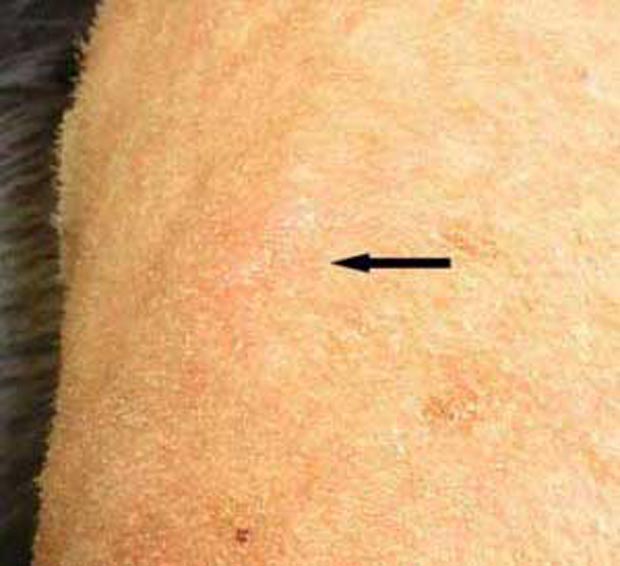Just like people, animals get a wide variety of cancers. Since all cancers have variable signs and behave differently in every animal, your pet should be brought to your veterinarian if it is showing any problems of any nature. The yearly preventive exam we recommend might detect the presence of cancer while it is still treatable and before it spreads to other organs.
Four common potentially malignant cancers in animals are skin cancer, lymph node cancer, breast cancer and spleen cancer.
Skin cancers vary greatly, from small and benign to large and malignant, some with serious additional problems. Of concern is a highly malignant skin cancer called a mast cell tumor (MST). There can be a swelling, redness, or a mass that comes and goes over several months as the only symptom.

This is a mast cell tumor, a malignant tumor that does not initially seem like much more than a small inflamed area of the skin. The small reddish area at the tip of the arrow is the mast cell. Obviously, it does not seem serious at this stage.
If we find a growth or significant swelling, we will perform an aspirate prior to any surgery and look at the cells for any signs of malignancy or cancer. This aspirate is easily obtained, does not require anesthesia, and is no more uncomfortable to your pet than a vaccine. The sample is sent to a pathologist that specializes in microscopic analysis of tissues. Only a few cells are obtained from this aspirate, so there is no guarantee that it gives us the complete picture. In spite of this, it is highly advantageous to perform this test.
If this aspirate gives us a good idea that cancer is present, and especially if the skin growth is getting larger or bothering your pet, we will remove it surgically for a definitive diagnosis and to stage it if it comes back malignant.
A suspected malignant skin cancer and healthy skin below and around it will be completely removed to make sure all of it is gone at the time of surgery. When we send the tissue in for diagnosis, the pathologist can let us know if we removed all the cancerous tissue. Once we get this report, we decide if further treatment, like radiation or chemotherapy, is needed.
Lymph node cancer, called lymphosarcoma (LSA) or malignant lymphoma, is a common cancer in dogs and cats. It is a cancer of the white blood cells and lymph nodes. Since it can affect many different organs, the symptoms are variable, and cats and dogs tend to get different forms and have different causes.
On physical examination, some pets with LSA will have enlarged peripheral lymph nodes or skin masses. LSA can sometimes be diagnosed with a blood panel that comprises the white blood cells in all species. This tumor can show up in any organ, so a radiograph and ultrasound are also commonly used in the diagnosis. Treatment ranges from surgery to chemotherapy, and the prognosis tends to be poor for the long term.
Several species of animals are prone to breast cancer. Dogs, cats and rats tend to be the most prevalent ones. Even though breast cancer occurs almost always in females, it can occur in males.
Breast cancer tends to occur most commonly in middle-aged and older dogs and cats that are not spayed. It might initially start as a swelling so minor that you do not notice it. Eventually, it can progress to the point where it is unsightly and uncomfortable for your pet.
Secondary infection with ulceration and pain can occur in breast cancer if left unchecked. Early detection is important for treatment; it confirms the need for wellness exams yearly—twice yearly for elderly pets or those with chronic conditions.
Treatment almost always involves surgery. The laser has revolutionized this surgery at Long Beach Animal Hospital; it has substantially decreased postoperative pain, swelling, and complications, particularly when we have to remove a large amount of mammary tissue. We have a webpage on laser surgery that will give you more information. Prior to surgery, we will run diagnostic tests; these include an X-ray, which helps us determine if the cancer has spread to the lungs and also lets us know if your pet is ready for anesthesia.
Several different surgeries are performed and depend mostly on the size and location of the tumor. If caught early enough, we can remove the tumor before it has a chance to spread to other parts of the body.
These tumors are readily prevented in females by performing a spay procedure prior to your pet’s first heat cycle. The longer you wait to spay your pet, the greater the chance of a tumor developing. This is especially important in cats since most of their tumors are malignant.
Our webpage on mammary tumors is filled with information, pictures and movies regarding this problem.
A tumor of the spleen, called hemangiosarcoma (HSA), can also occur in the heart and less commonly in the liver. Symptoms can be subtle and easy to miss. Typically, they might include lethargy, weakness and weight loss. Sudden death can occur if the spleen ruptures. If not caught early enough, it can also spread to the heart.
During an exam, we might palpate an enlargement in the abdomen. This is confirmed with radiography and ultrasound. We can even do an ultrasound-guided aspirate for more information.
Surgery is the treatment of choice in splenic HSA. These tumors can rupture and cause immediate collapse and even death, so surgery should be performed soon after the diagnosis. Chemotherapy is instituted after surgery in some cases.
Our website has detailed information on mast cell cancer, laser, breast cancer and HSA. This includes pictures and movies of diagnosis and treatment. Follow the Diseases link on the homepage.

